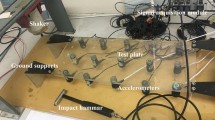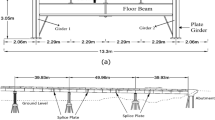Abstract
Among all the structural vibration characteristics, natural frequencies are relatively simple and accurate to measure, and provide the structural global damage information. In this paper, the feasibility of using only natural frequencies to identify structural damage is exploited by adopting two usual approaches, namely, sensitivity analysis and neural networks. Some aspects of damage detection such as the problem of incomplete modal test data and robustness of detection are considered. A laboratory tested 3-storey frame is used to demonstrate the possibility of frequency-based damage detection techniques. The numerical results show that the damaged element can be correctly localized and the content of damage can be identified with relatively high degree of accuracy by using the changes in frequencies.
Similar content being viewed by others
References
Capecchi D, Vestroni F. Monitoring of Structural Systems by Using Frequency Data.Earthquake Engineering and Structural Dynamics, 1999,28:447–461.
Cawley P, Adams R D. The Location of Defects in Structures from Measurements of Natural Frequencies.Journal of Strain Analysis, 1979,14:49–57.
Biswas M, Pandey A K, Samman M M. Diagnostic Experimental Spectral/modal Analysis of A Highway Bridge.The International Journal of Analytical and Experimental Modal Analysis, 1990,5:33–42.
Zhu H, Wu M. The Characteristic Receptance Method for Damage Detection in Large Mono-Coupled Periodic Structures.Journal of Sound & Vibration, 2002,251(2):241–259.
Stubbs N, Broome T H, Osegueda, R. Non-Destructive Construction Error Detection in Large Space Structures.AIAA Journal, 1990,28:146–152.
Zhu H, Shima Y. Damage Detection in Structures Using Modified Back-Propagation Neural Networks.Acta MECHANICA SOLIDA Sinica, 2002,15(4): 358–370.
Xu Y L, Zhan S, Ko J M,et al. Experimental Investigation of Adjacent Buildings Connected by Fluid Damper. Earthquake Engineering and Structural Dynamics, 1999,28: 609–631.
Author information
Authors and Affiliations
Additional information
Foundation item: Supported by the National Natural Science Foundation of China (No. 50378041) and the Specialized Research Fund for the Doctoral Program of Higher Education (Grant No. 20030487016).
Biography: ZHU Hong-ping (1965-), male, Professor, Ph. D., research direction: structural damage detection and structural vibration control.
Rights and permissions
About this article
Cite this article
Hong-ping, Z., Bo, H. & Xiao-qiang, C. Detection of structural damage through changes in frequency. Wuhan Univ. J. Nat. Sci. 10, 1069–1073 (2005). https://doi.org/10.1007/BF02832469
Received:
Issue Date:
DOI: https://doi.org/10.1007/BF02832469




